Exploring the Multiscale Relationship between the Built Environment and the Metro-Oriented Dockless Bike-Sharing Usage
Abstract
:1. Introduction
2. Literature Review
3. Study Area and Data Description
3.1. Study Area
3.2. Data Description
- (1)
- The bike-sharing trip record data are obtained from the competition of Mobike Big Data Challenge 2017. The original data set includes more than 1.83 million Mobike bike-sharing trip records in Beijing from 10–16 May 2017. By querying the weather condition records of Beijing, we can see that the weather was sunny and the air quality was also good in Beijing during that period [46], Therefore, the bike-sharing trajectory data during this period can reflect the real usage of Mobike bicycle in Beijing comprehensively. Each trip record includes order id, user id, vehicle id, vehicle type, start time, origin location, and destination location. The coordinate system of the origin and destination location is the GCJ-02 coordinate system, which is the official Chinese geodetic datum formulated by the Chinese State Bureau of Surveying and Mapping. The coordinates of origin location and destination location were encoded using the geohash, which is a method of encoding geographic coordinates to protect privacy information [47]. The principle of geohash is mapping all coordinates of a specific rectangular range to the same string, such that the longer the string, the higher the precision. Since the length of geohash code is 7 bits, the spatial resolution of the decoded bike-sharing ride original and destination point coordinates is approximately equal to 110 m * 150 m. The Manhattan distance formula is applied to calculate the riding distance for each trip order [48]. The calculation results show that more than 95% of the orders have a riding distance of 2000 m or less. As this study focuses on the characteristics of bike-sharing connected to the metro, in order to simplify the processing, the data with a riding distance of more than 2000 m are regarded as invalid data and eliminated.
- (2)
- Built environment data includes road network data, points of interest (POI) data and population density data. The road network data was obtained from the website of OpenStreetMap (https://www.openstreetmap.org/, accessed on 10 July 2017), including three road types: primary road, secondary road, and branch road. The POI data was obtained from Amap (https://www.amap.com, accessed on 7 July 2020), which includes 13 POI categories such as catering facilities, scenic spots, public service facilities, companies, shopping facilities, and transportation facilities. Each POI record includes name, type, location, latitude, and longitude of the specific location such that the coordinate system of location is also the GCJ-02 coordinate system. By cleaning the original POI data, 502,376 POI records were obtained for further analysis. The population density data were obtained from the WorldPop dataset (https://www.worldpop.org/project/categories, accessed on 1 December 2017), with a spatial resolution of 1 km × 1 km. Some studies have shown that the WorldPop dataset had the highest estimation accuracy in population datasets of China [49]. Finally, the coordinate systems of all data are unified to the WGS 1984 coordinate system.
4. Method
4.1. Determining the Research Units of the Bike-Sharing Usage and the Built Environment
4.2. Screening the Independent Variables
4.3. Spatial Non-Stationarity Test
4.4. Models
4.4.1. The Geographically Weighted Regression Model
4.4.2. The Multiscale Geographically Weighted Regression Model
4.5. Model Evaluation Metrics
5. Results and Analysis
5.1. Building and Results of Regression Models
5.2. The Fitting Results of Regression Models
5.3. Discussion on the Spatially Varying Effects
6. Conclusions and Prospect
- The multicollinearity test result of the ordinary least square (OLS) model showed that among the initial urban built environment variables, the distance to central business district (CBD), the Hotels-Residences points of interest (POI) density, the primary road density, the secondary road density, the branch road density, and the population density have significant impact on the dockless bike-sharing riding connected to the metro stations. However, the spatial autocorrelation test results of the residual of OLS model proved the existence of spatial non-stationarity.
- The geographically weighted regression (GWR) model and multiscale geographically weighted regression (MGWR) model can both solve the problem of spatial non-stationarity compared with the OLS model. Since the MGWR model can identify the difference of effect scales between each variable, it is more reliable than the GWR model and the OLS model for analyzing the spatial relationship between the built environment and the usage of bike-sharing connected to the metro stations.
- Whether on weekdays or at weekends, the Hotels-Residences POI density and the branch road density have a positive effect on bike-sharing usage, while the secondary road density has a negative effect on bike-sharing usage. The population density only has a positive effect on bike-sharing usage on weekends. The primary road density has a negative effect on access-daily usage of bike-sharing and a positive effect on egress-daily usage of bike-sharing.
- The effects of the built environment variables on bike-sharing usage vary in space. The estimated coefficient of the distance to CBD varies most across space, while the estimated coefficient of the primary road density varies less. Within the fifth ring road, the distance to CBD has a positive effect on bike-sharing usage, while outside the fifth ring road, the effect is negative. In addition, most of the remaining variables have a greater effect on bike-sharing usage in the eastern part of the study area.
Author Contributions
Funding
Institutional Review Board Statement
Informed Consent Statement
Data Availability Statement
Acknowledgments
Conflicts of Interest
References
- Zhao, R.; Yang, L.C.; Liang, X.R.; Guo, Y.Y.; Lu, Y.; Zhang, Y.X.; Ren, X.Y. Last-Mile Travel Mode Choice: Data-Mining Hybrid with Multiple Attribute Decision Making. Sustainability 2019, 11, 6733. [Google Scholar] [CrossRef] [Green Version]
- Adnan, M.; Altaf, S.; Bellemans, T.; Yasar, A.U.H.; Shakshuki, E.M. Last-mile travel and bicycle sharing system in small/medium sized cities: User’s preferences investigation using hybrid choice model. J. Ambient. Intell. Humaniz. Comput. 2019, 10, 4721–4731. [Google Scholar] [CrossRef]
- Yang, Y.X.; Heppenstall, A.; Turner, A.; Comber, A. A spatiotemporal and graph-based analysis of dockless bike sharing patterns to understand urban flows over the last mile. Comput. Environ. Urban Syst. 2019, 77, 101361. [Google Scholar] [CrossRef]
- Qiu, L.Y.; He, L.Y. Bike Sharing and the Economy, the Environment, and Health-Related Externalities. Sustainability 2018, 10, 1145. [Google Scholar] [CrossRef] [Green Version]
- Cerutti, P.S.; Martins, R.D.; Macke, J.; Sarate, J.A.R. “Green, but not as green as that”: An analysis of a Brazilian bike-sharing system. J. Clean. Prod. 2019, 217, 185–193. [Google Scholar] [CrossRef]
- Otero, I.; Nieuwenhuijsen, M.J.; Rojas-Rueda, D. Health impacts of bike sharing systems in Europe. Environ. Int. 2018, 115, 387–394. [Google Scholar] [CrossRef]
- Oja, P.; Vuori, I.; Paronen, O. Daily walking and cycling to work: Their utility as health-enhancing physical activity. Patient Educ. Couns. 1998, 33, S87–S94. [Google Scholar] [CrossRef]
- Lamu, A.N.; Jbaily, A.; Verguet, S.; Robberstad, B.; Norheim, O.F. Is cycle network expansion cost-effective? A health economic evaluation of cycling in Oslo. BMC Public Health 2020, 20, 1869. [Google Scholar] [CrossRef]
- Titze, S.; Merom, D.; Rissel, C.; Bauman, A. Epidemiology of cycling for exercise, recreation or sport in Australia and its contribution to health-enhancing physical activity. J. Sci. Med. Sport 2014, 17, 485–490. [Google Scholar] [CrossRef]
- Li, W.; Chen, S.; Dong, J.; Wu, J. Exploring the spatial variations of transfer distances between dockless bike-sharing systems and metros. J. Transp. Geogr. 2021, 92, 103032. [Google Scholar] [CrossRef]
- Chen, E.H.; Ye, Z.R. Identifying the nonlinear relationship between free-floating bike sharing usage and built environment. J. Clean. Prod. 2021, 280, 124281. [Google Scholar] [CrossRef]
- Guo, Y.Y.; He, S.Y. Built environment effects on the integration of dockless bike-sharing and the metro. Transp. Res. Part D-Transp. Environ. 2020, 83, 102335. [Google Scholar] [CrossRef]
- Liu, D.; Zhang, K.P.; Xie, B.L.; Destech Publicat, I. Exploring the Effects of Building Environments on the Use of Bike Sharing. Case Study of Shenzhen, China. DEStech Trans. Environ. Energ. Earth Sci. 2019, 334, 158–162. [Google Scholar] [CrossRef]
- Wu, C.L.; Chung, H.; Liu, Z.Y.; Kim, I. Examining the effects of the built environment on topological properties of the bike-sharing network in Suzhou, China. Int. J. Sustain. Transp. 2021, 15, 338–350. [Google Scholar] [CrossRef]
- Dean, M.D.; Kockelman, K.M. Spatial variation in shared ride-hail trip demand and factors contributing to sharing: Lessons from Chicago. J. Transp. Geogr. 2021, 91, 102944. [Google Scholar] [CrossRef]
- Gao, F.; Li, S.Y.; Tan, Z.Z.; Zhang, X.M.; Lai, Z.P.; Tan, Z.L. How Is Urban Greenness Spatially Associated with Dockless Bike Sharing Usage on Weekdays, Weekends, and Holidays? ISPRS Int. J. Geo-Inf. 2021, 10, 238. [Google Scholar] [CrossRef]
- Wu, C.; Kim, I.; Chung, H. The effects of built environment spatial variation on bike-sharing usage: A case study of Suzhou, China. Cities 2021, 110, 103063. [Google Scholar] [CrossRef]
- Radzimski, A.; Dziecielski, M. Exploring the relationship between bike-sharing and public transport in Poznan, Poland. Transp. Res. Part A-Policy Pract. 2021, 145, 189–202. [Google Scholar] [CrossRef]
- Fotheringham, A.S.; Yang, W.B.; Kang, W. Multiscale Geographically Weighted Regression (MGWR). Ann. Am. Assoc. Geogr. 2017, 107, 1247–1265. [Google Scholar] [CrossRef]
- Shabrina, Z.; Buyuklieva, B.; Ng, M.K.M. Short-Term Rental Platform in the Urban Tourism Context: A Geographically Weighted Regression (GWR) and a Multiscale GWR (MGWR) Approaches. Geogr. Anal. 2021, 53, 686–707. [Google Scholar] [CrossRef]
- Iyanda, A.E.; Osayomi, T. Is there a relationship between economic indicators and road fatalities in Texas? A multiscale geographically weighted regression analysis. Geojournal 2021, 86, 2787–2807. [Google Scholar] [CrossRef]
- Ewing, R.; Cervero, R. Travel and the built environment—A synthesis. Transp. Res. Rec. 2001, 87–114. [Google Scholar] [CrossRef] [Green Version]
- Vallez, C.M.; Castro, M.; Contreras, D. Challenges and Opportunities in Dock-Based Bike-Sharing Rebalancing: A Systematic Review. Sustainability 2021, 13, 1829. [Google Scholar] [CrossRef]
- Albuquerque, V.; Dias, M.S.; Bacao, F. Machine Learning Approaches to Bike-Sharing Systems: A Systematic Literature Review. ISPRS Int. J. Geo-Inf. 2021, 10, 62. [Google Scholar] [CrossRef]
- Eren, E.; Uz, V.E. A review on bike-sharing: The factors affecting bike-sharing demand. Sustain. Cities Soc. 2020, 54, 101882. [Google Scholar] [CrossRef]
- Ahillen, M.; Mateo-Babiano, D.; Corcoran, J. Dynamics of bike sharing in Washington, DC and Brisbane, Australia: Implications for policy and planning. Int. J. Sustain. Transp. 2016, 10, 441–454. [Google Scholar] [CrossRef]
- Buehler, R.; Pucher, J. Cycling to work in 90 large American cities: New evidence on the role of bike paths and lanes. Transportation 2012, 39, 409–432. [Google Scholar] [CrossRef]
- Faghih-Imani, A.; Hampshire, R.; Marla, L.; Eluru, N. An empirical analysis of bike sharing usage and rebalancing: Evidence from Barcelona and Seville. Transp. Res. Part A-Policy Pract. 2017, 97, 177–191. [Google Scholar] [CrossRef]
- Nair, R.; Miller-Hooks, E.; Hampshire, R.C.; Busic, A. Large-Scale Vehicle Sharing Systems: Analysis of Velib’. Int. J. Sustain. Transp. 2013, 7, 85–106. [Google Scholar] [CrossRef] [Green Version]
- Rixey, R.A. Station-Level Forecasting of Bikesharing Ridership Station Network Effects in Three US Systems. Transp. Res. Rec. 2013, 2387, 46–55. [Google Scholar] [CrossRef] [Green Version]
- Zhang, Y.; Thomas, T.; Brussel, M.; van Maarseveen, M. Exploring the impact of built environment factors on the use of public bikes at bike stations: Case study in Zhongshan, China. J. Transp. Geogr. 2017, 58, 59–70. [Google Scholar] [CrossRef]
- Lin, J.J.; Zhao, P.J.; Takada, K.; Li, S.X.; Yai, T.S.; Chen, C.H. Built environment and public bike usage for metro access: A comparison of neighborhoods in Beijing, Taipei, and Tokyo. Transp. Res. Part D-Transp. Environ. 2018, 63, 209–221. [Google Scholar] [CrossRef]
- Faghih-Imani, A.; Eluru, N. Incorporating the impact of spatio-temporal interactions on bicycle sharing system demand: A case study of New York CitiBike system. J. Transp. Geogr. 2016, 54, 218–227. [Google Scholar] [CrossRef]
- Faghih-Imani, A.; Eluru, N.; El-Geneidy, A.M.; Rabbat, M.; Haq, U. How land-use and urban form impact bicycle flows: Evidence from the bicycle-sharing system (BIXI) in Montreal. J. Transp. Geogr. 2014, 41, 306–314. [Google Scholar] [CrossRef]
- Li, A.; Zhao, P.; Huang, Y.; Gao, K.; Axhausen, K.W. An empirical analysis of dockless bike-sharing utilization and its explanatory factors: Case study from Shanghai, China. J. Transp. Geogr. 2020, 88, 102828. [Google Scholar] [CrossRef]
- Wang, Z.J.; Cheng, L.; Li, Y.X.; Li, Z.Q. Spatiotemporal Characteristics of Bike-Sharing Usage around Rail Transit Stations: Evidence from Beijing, China. Sustainability 2020, 12, 1299. [Google Scholar] [CrossRef] [Green Version]
- Bao, J.; Shi, X.M.; Zhang, H. Spatial Analysis of Bikeshare Ridership with Smart Card and POI Data Using Geographically Weighted Regression Method. IEEE Access 2018, 6, 76049–76059. [Google Scholar] [CrossRef]
- Gao, F.; Li, S.; Tan, Z.; Wu, Z.; Zhang, X.; Huang, G.; Huang, Z. Understanding the modifiable areal unit problem in dockless bike sharing usage and exploring the interactive effects of built environment factors. Int. J. Geogr. Inf. Sci. 2021, 35, 1905–1925. [Google Scholar] [CrossRef]
- Lyu, C.; Wu, X.H.; Liu, Y.; Yang, X.; Liu, Z.Y. Exploring multi-scale spatial relationship between built environment and public bicycle ridership: A case study in Nanjing. J. Transp. Land Use 2020, 13, 447–467. [Google Scholar] [CrossRef]
- Statistics. China Statistical Yearbook. 2017. Available online: http://www.stats.gov.cn/tjsj/ndsj/2017/indexch.htm (accessed on 7 July 2020).
- Xue, G.; Gong, D.Q.; Zhang, J.H.; Zhang, P.; Tai, Q.M. Passenger Travel Patterns and Behavior Analysis of Long-Term Staying in Subway System by Massive Smart Card Data. Energies 2020, 13, 2670. [Google Scholar] [CrossRef]
- Xu, Y.F.; Zhang, Q.H.; Zheng, S.Q. The rising demand for subway after private driving restriction: Evidence from Beijing’s housing market. Reg. Sci. Urban Econ. 2015, 54, 28–37. [Google Scholar] [CrossRef]
- de Siqueira, A.J.; do Almo, P.M.; Cicerelli, R.E.; Machado, R.F.C.; de Almeida, T.; IEEE. Mapping the usability and quality of bicycle paths using a terrain-inclination-based classification, study case: Darcy ribeiro campus, university of Brasilia, Brazil. In Proceedings of the IEEE Latin American GRSS and ISPRS Remote Sensing Conference (LAGIRS), Santiago, Chile, 21–26 March 2020; pp. 78–81. [Google Scholar]
- Fan, Y.C.; Zheng, S.Q. Dockless bike sharing alleviates road congestion by complementing subway travel: Evidence from Beijing. Cities 2020, 107, 102895. [Google Scholar] [CrossRef]
- Gao, P.; Li, J.Y. Understanding sustainable business model: A framework and a case study of the bike-sharing industry. J. Clean. Prod. 2020, 267, 122229. [Google Scholar] [CrossRef]
- Weather. Beijing, People’s Republic of China Weather History. Available online: https://www.wunderground.com/history/monthly/cn/beijing/ZBNY/date/2017-5 (accessed on 7 July 2020).
- Moussalli, R.; Srivatsa, M.; Asaad, S. Fast and Flexible Conversion of Geohash Codes to and from Latitude/Longitude Coordinates. In Proceedings of the 2015 IEEE 23rd Annual International Symposium on Field-Programmable Custom Computing Machines (FCCM), Vancouver, BC, Canada, 3–5 May 2015; pp. 179–186. [Google Scholar]
- Bender, C.M.; Bender, M.A.; Demaine, E.D.; Fekete, S.P. What is the optimal shape of a city? J. Phys. A-Math. Gen. 2004, 37, 147–159. [Google Scholar] [CrossRef]
- Bai, Z.Q.; Wang, J.L.; Wang, M.M.; Gao, M.X.; Sun, J.L. Accuracy Assessment of Multi-Source Gridded Population Distribution Datasets in China. Sustainability 2018, 10, 1363. [Google Scholar] [CrossRef] [Green Version]
- Yang, H.T.; Li, X.; Li, C.J.; Huo, J.H.; Liu, Y.G. How Do Different Treatments of Catchment Area Affect the Station Level Demand Modeling of Urban Rail Transit? J. Adv. Transp. 2021, 2021, 2763304. [Google Scholar] [CrossRef]
- Fritz, M.; Berger, P.D. Can you relate in multiple ways? Multiple linear regression and stepwise regression. In Improving the User Experience through Practical Data Analytics; Elsevier Inc.: Boston, MA, USA, 2015; pp. 239–269. [Google Scholar]
- Lavery, M.R.; Acharya, P.; Sivo, S.A.; Xu, L.H. Number of predictors and multicollinearity: What are their effects on error and bias in regression? Commun. Stat.-Simul. Comput. 2019, 48, 27–38. [Google Scholar] [CrossRef]
- Moran, P.A. The interpretation of statistical maps. J. R. Stat. Soc. Ser. B 1948, 10, 243–251. [Google Scholar] [CrossRef]
- Anselin, L. Spatial Econometrics: Methods and Models; Springer Science & Business Media: Berlin/Heidelberg, Germany, 1988. [Google Scholar]
- Brunsdon, C.; Fotheringham, S.; Charlton, M. Geographically weighted regression—Modelling spatial non-stationarity. J. R. Stat. Soc. Ser. D-Stat. 1998, 47, 431–443. [Google Scholar] [CrossRef]
- Kang, L.J.; Di, L.P.; Deng, M.X.; Shao, Y.Z.; Yu, G.N.; Shrestha, R. Use of Geographically Weighted Regression Model for Exploring Spatial Patterns and Local Factors Behind NDVI-Precipitation Correlation. IEEE J. Sel. Top. Appl. Earth Obs. Remote Sens. 2014, 7, 4530–4538. [Google Scholar] [CrossRef]
- Zhong, S.P.; Wang, Z.; Wang, Q.Z.; Liu, A.; Cui, J.Q. Exploring the Spatially Heterogeneous Effects of Urban Built Environment on Road Travel Time Variability. J. Transp. Eng. Part A-Syst. 2021, 147, 04020142. [Google Scholar] [CrossRef]
- Yu, H.C.; Fotheringham, A.S.; Li, Z.Q.; Oshan, T.; Kang, W.; Wolf, L.J. Inference in Multiscale Geographically Weighted Regression. Geogr. Anal. 2020, 52, 87–106. [Google Scholar] [CrossRef]
- Akaike, H. A new look at the statistical model identification. IEEE Trans. Autom. Control 1974, 19, 716–723. [Google Scholar] [CrossRef]
- Yue, Y.; Zhuang, Y.; Yeh, A.G.O.; Xie, J.Y.; Ma, C.L.; Li, Q.Q. Measurements of POI-based mixed use and their relationships with neighbourhood vibrancy. Int. J. Geogr. Inf. Sci. 2017, 31, 658–675. [Google Scholar] [CrossRef] [Green Version]
- Fotheringham, A.S.; Kelly, M.H.; Charlton, M. The demographic impacts of the Irish famine: Towards a greater geographical understanding. Trans. Inst. Br. Geogr. 2013, 38, 221–237. [Google Scholar] [CrossRef]
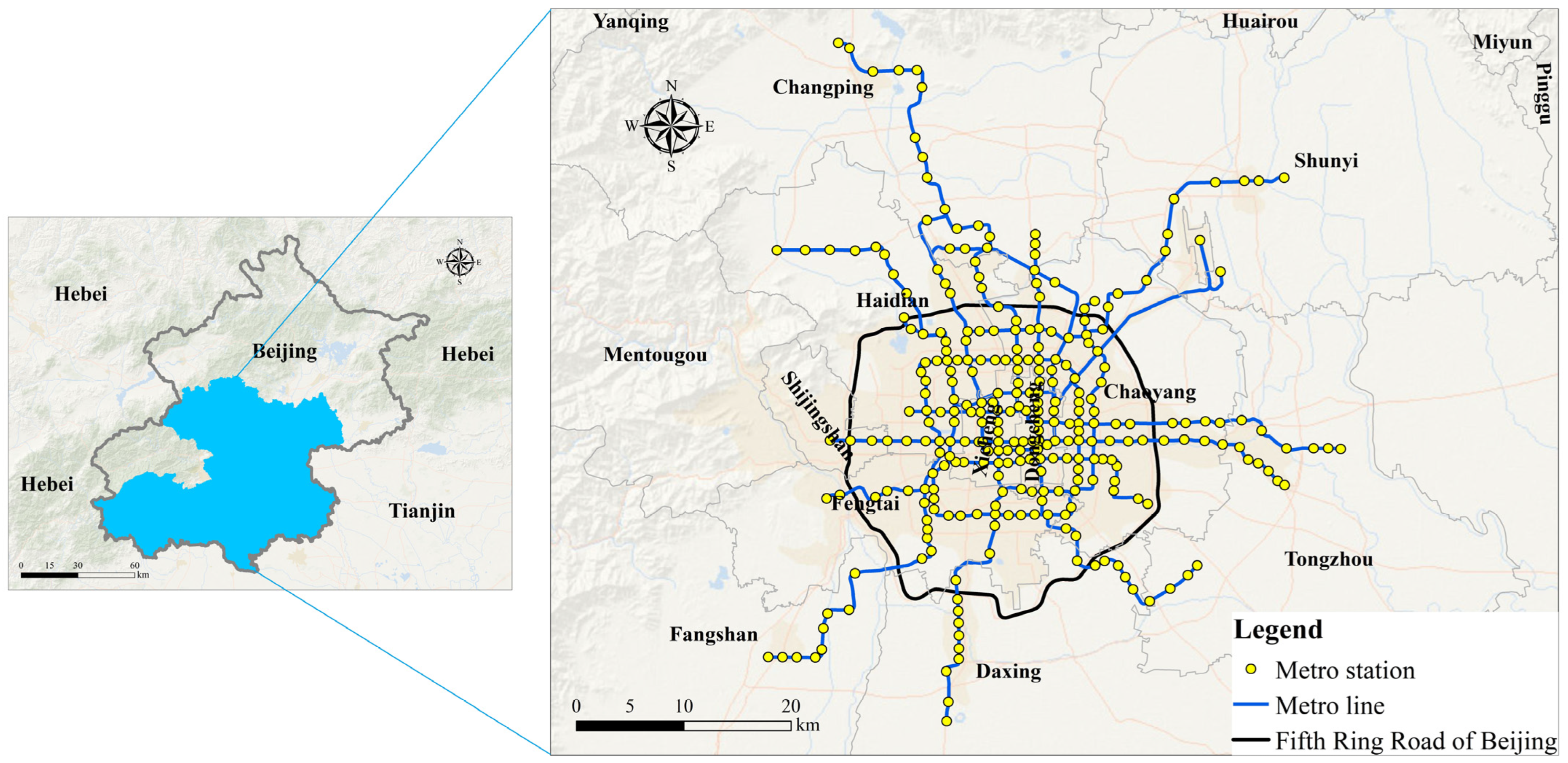
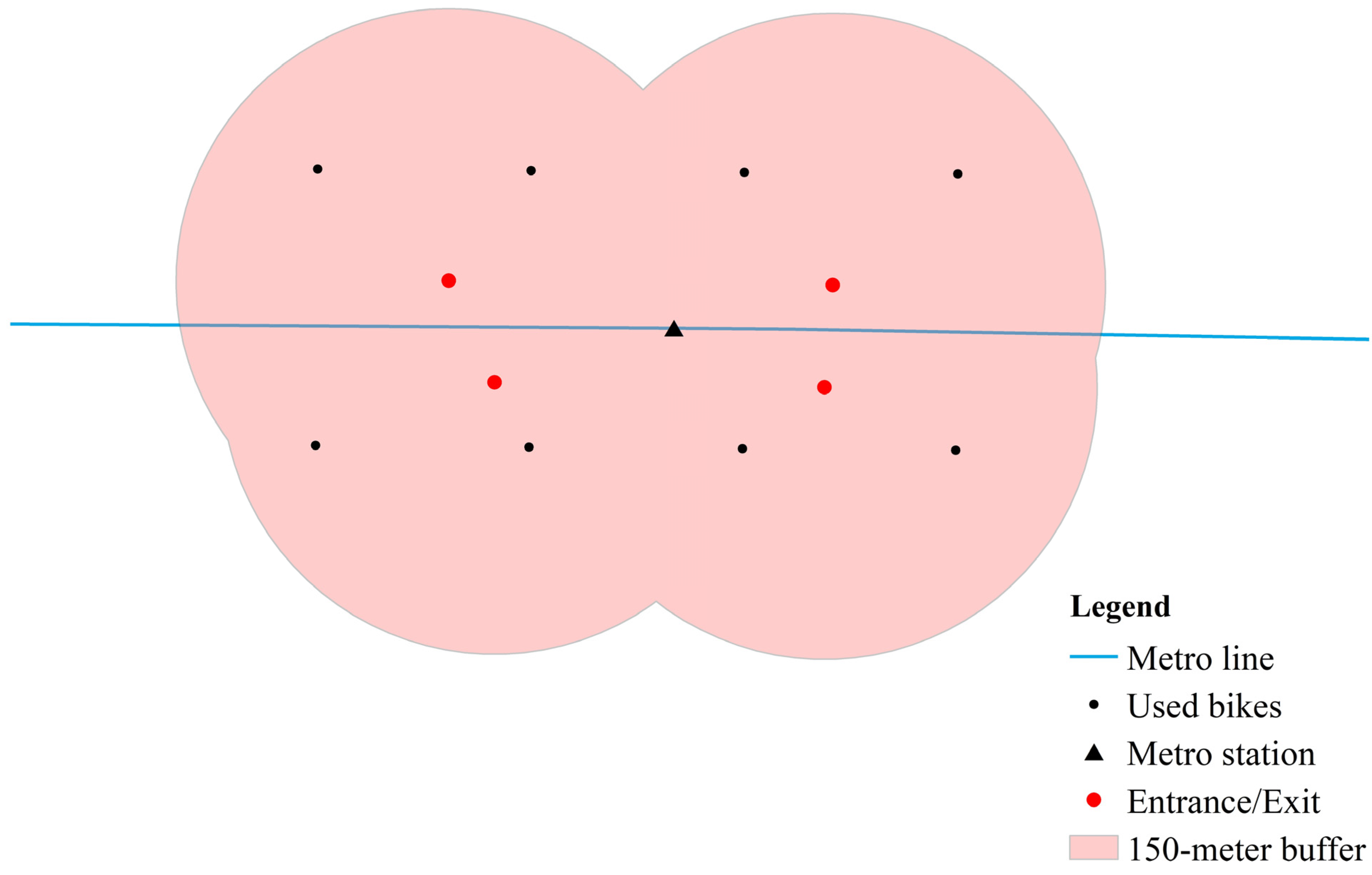
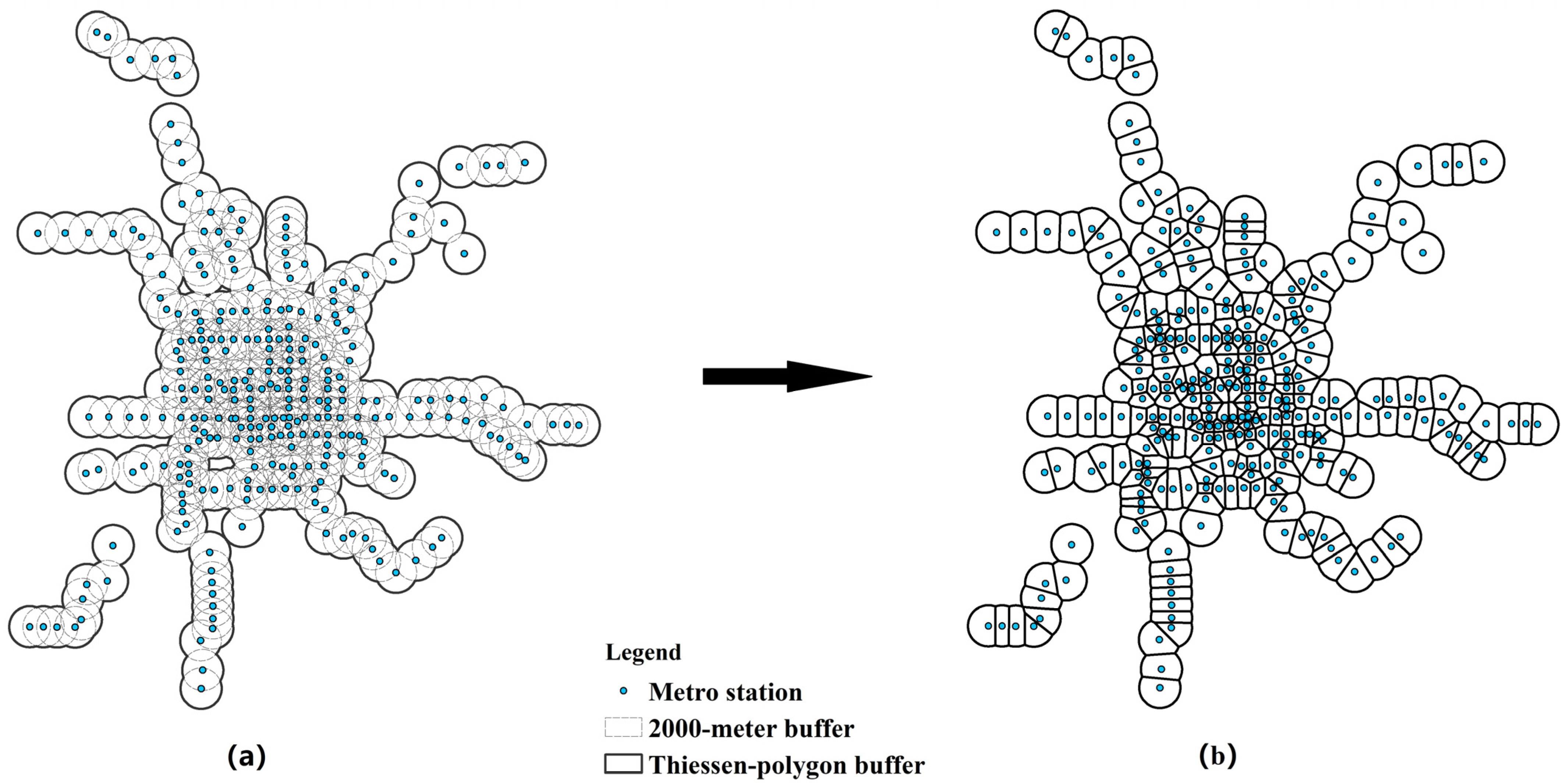
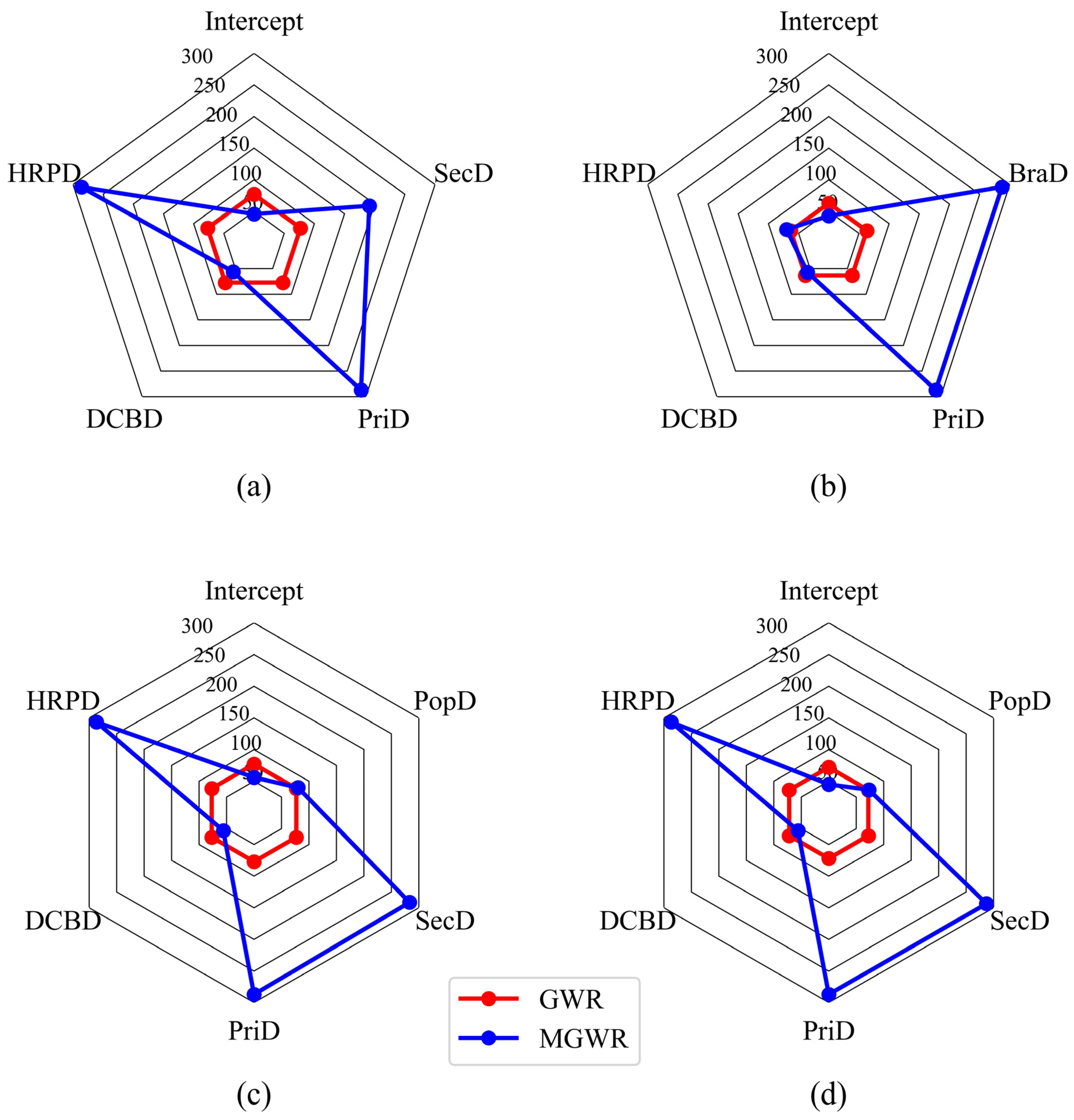
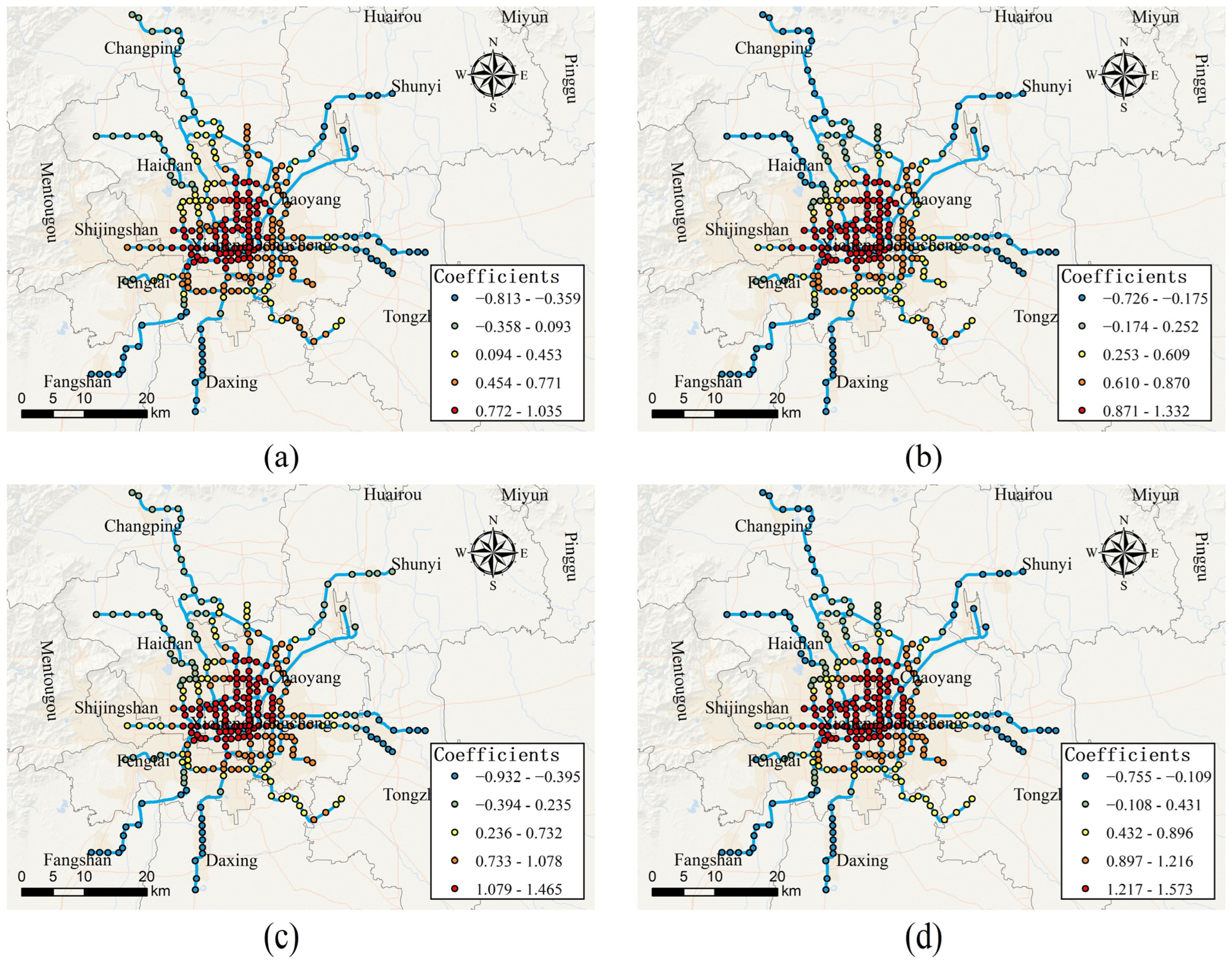
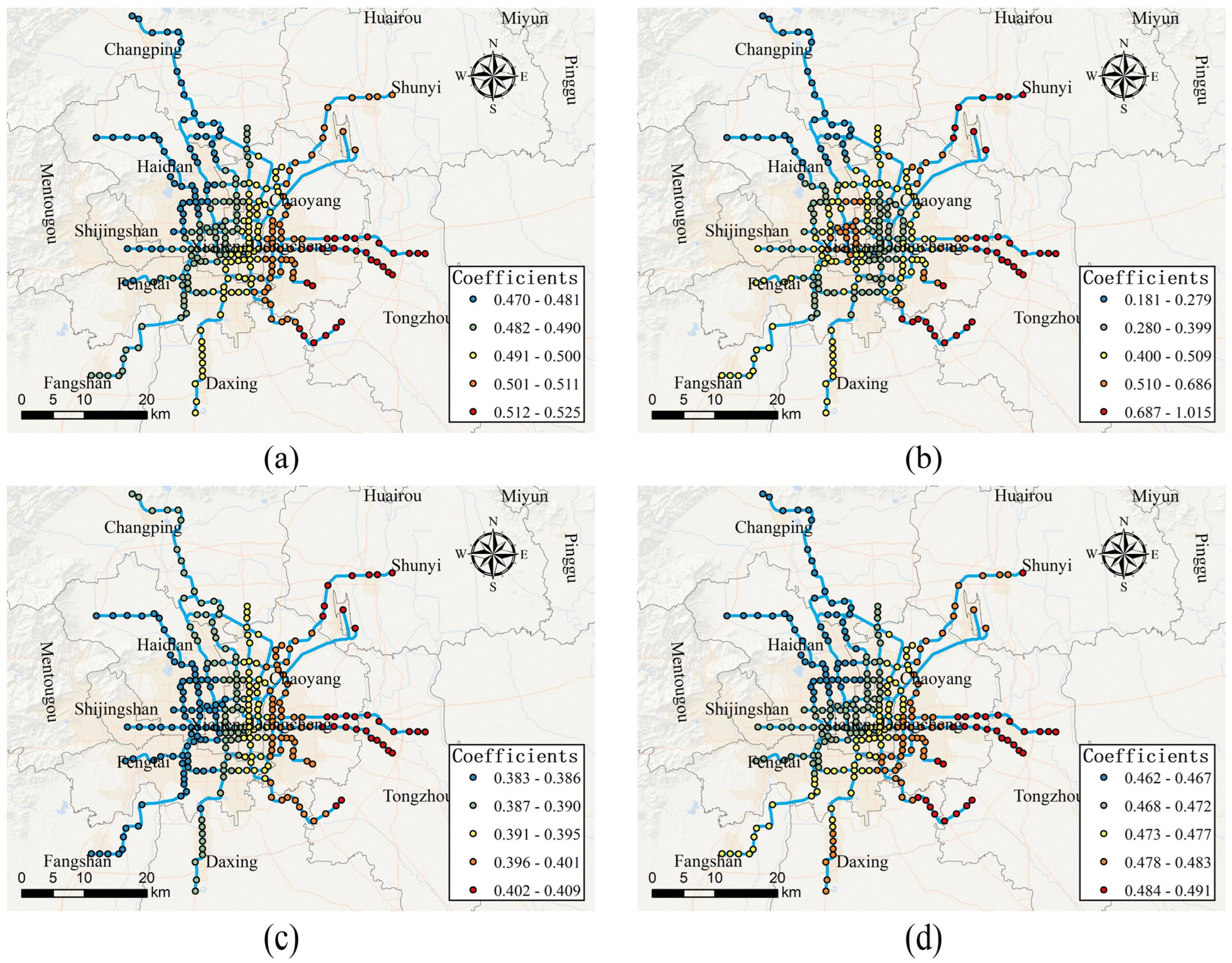
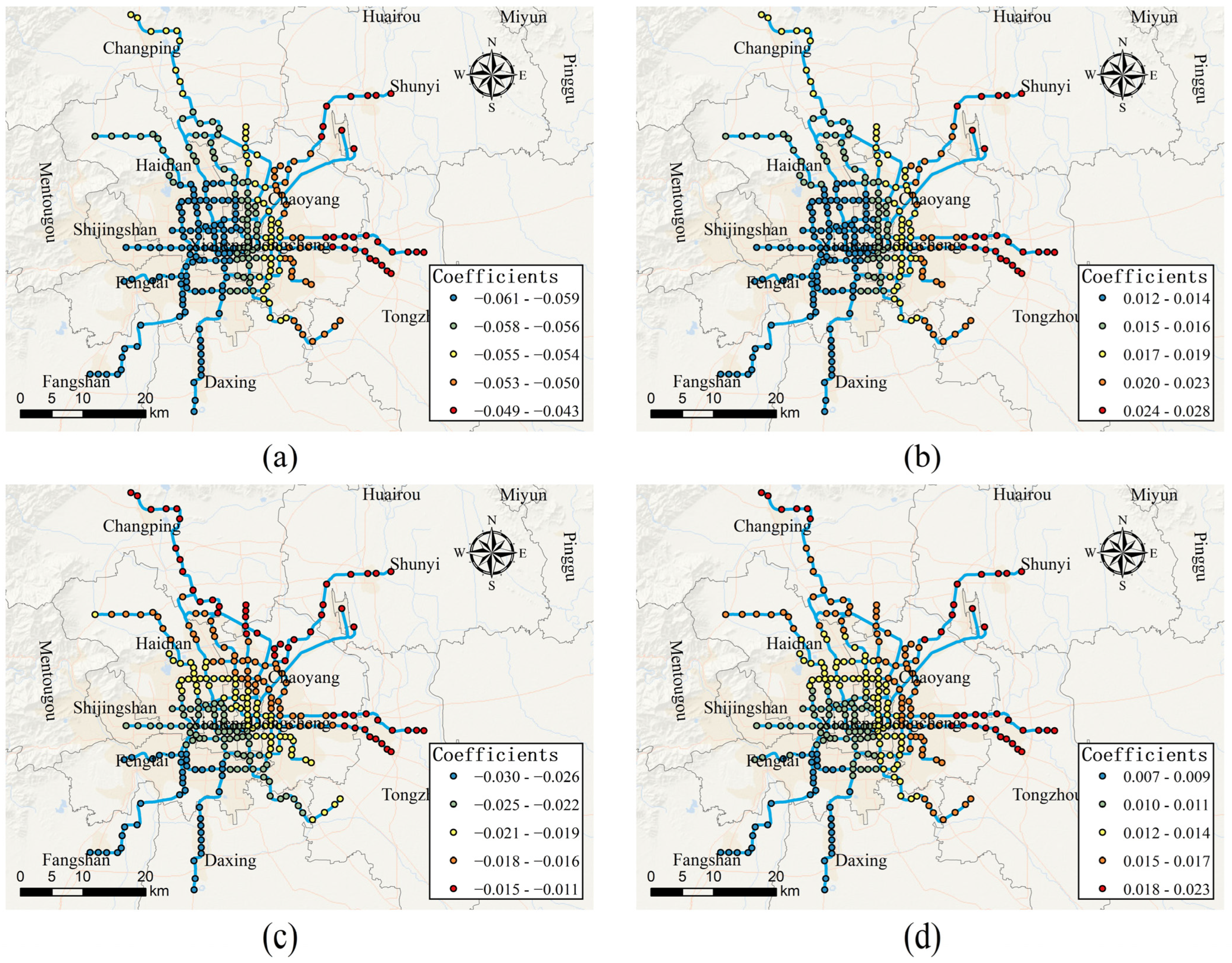
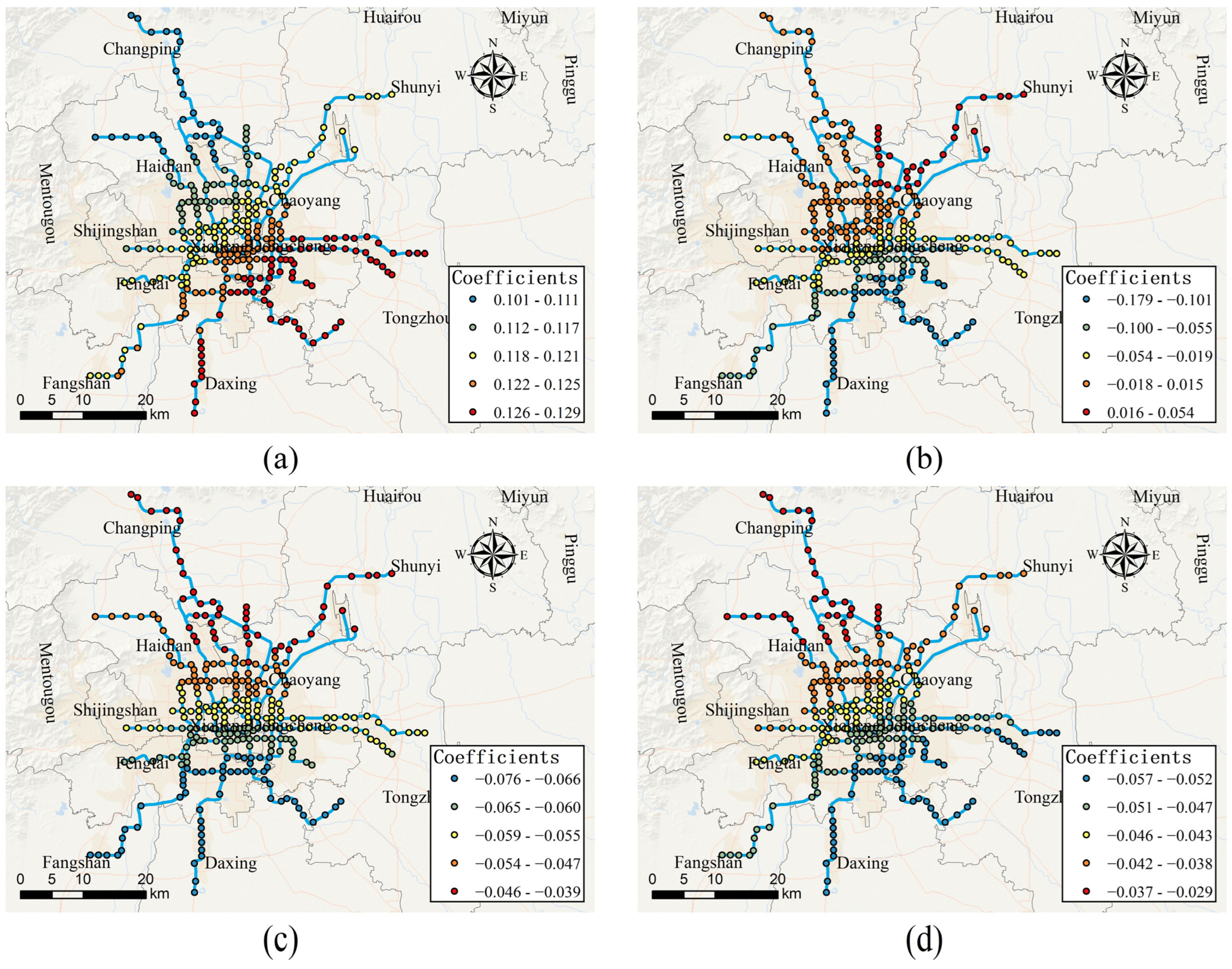
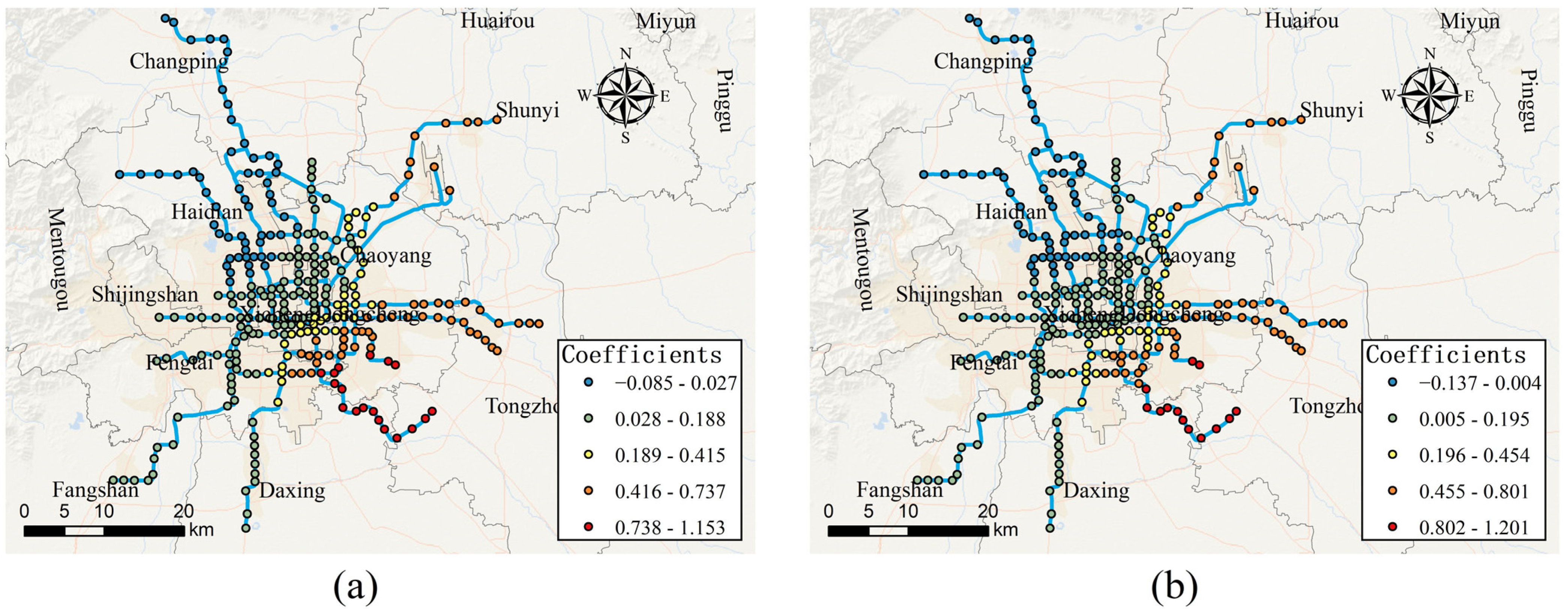
| Categories | Variables | Abbreviation | Mean | Std. |
|---|---|---|---|---|
| Dependent variable | Access-daily use on weekdays (number per day) | / | 162.810 | 133.663 |
| Egress-daily use on weekdays (number per day) | / | 156.356 | 126.934 | |
| Access-daily use on weekends (number per day) | / | 106.585 | 92.015 | |
| Egress-daily use on weekends (number per day) | / | 104.602 | 89.301 | |
| Density | Population density (number/km2) | PopD | 17.459 | 14.102 |
| Diversity | Land-use mixture | LMix | 0.921 | 0.073 |
| Design | Primary road density (km/km2) | PriD | 0.541 | 0.806 |
| Secondary road density (km/km2) | SecD | 1.149 | 1.066 | |
| Branch road density (km/km2) | BraD | 2.702 | 1.428 | |
| Destination accessibility | Distance to CBD (km) | DCBD | 13.609 | 8.526 |
| Distance to transit | Bus station density (number/km2) | BusD | 4.598 | 2.796 |
| Other POIs | Restaurants-Shopping POI density (number/km2) | RSPD | 62.424 | 52.904 |
| Companies-Banks POI density (number/km2) | CBPD | 139.600 | 155.524 | |
| Hotels-Residences POI density (number/km2) | HRPD | 32.842 | 24.938 | |
| Schools-Sports POI density (number/km2) | SSPD | 76.039 | 65.748 |
| Variables | Access-Daily Use on Weekdays | Egress-Daily Use on Weekdays | Access-Daily Use on Weekends | Egress-Daily Use on Weekends | ||||
|---|---|---|---|---|---|---|---|---|
| VIF | VIF | VIF | VIF | |||||
| DCBD | ||||||||
| HRPD | ||||||||
| PriD | ||||||||
| SecD | - | - | ||||||
| BraD | - | - | - | - | - | - | ||
| PopD | - | - | - | - | ||||
| Variable | Moran’s I | z-Score | p-Value |
|---|---|---|---|
| DCBD | 0.979444 | 26.639919 | 0.000 |
| HRPD | 0.615647 | 16.755601 | 0.000 |
| PriD | 0.523332 | 14.35121 | 0.000 |
| SecD | 0.428045 | 11.700967 | 0.000 |
| BraD | 0.310168 | 8.495692 | 0.000 |
| PopD | 0.412146 | 11.393449 | 0.000 |
| Metrics | Access-Daily Use on Weekdays | Egress-Daily Use on Weekdays | ||||
|---|---|---|---|---|---|---|
| OLS | GWR | MGWR | OLS | GWR | MGWR | |
| 0.240 | 0.485 | 0.498 | 0.256 | 0.570 | 0.559 | |
| 0.229 | 0.398 | 0.442 | 0.246 | 0.480 | 0.500 | |
| AICc | 750.483 | 726.361 | 686.154 | 744.359 | 697.108 | 660.930 |
| Moran’s I (residuals) | 0.258737 (0.00) * | 0.046537 (0.17) | 0.030440 (0.35) | 0.321465 (0.00) * | 0.058202 (0.09) | 0.051092 (0.13) |
| Metrics | Access-Daily Use on Weekends | Egress-Daily Use on Weekends | ||||
| OLS | GWR | MGWR | OLS | GWR | MGWR | |
| 0.193 | 0.510 | 0.509 | 0.215 | 0.552 | 0.546 | |
| 0.179 | 0.408 | 0.446 | 0.201 | 0.451 | 0.481 | |
| AICc | 769.942 | 734.265 | 689.091 | 762.113 | 718.003 | 674.457 |
| Moran’s I (residuals) | 0.260169 (0.00) * | 0.039950 (0.22) | 0.029660 (0.35) | 0.297075 (0.00) * | 0.042165 (0.21) | 0.030656 (0.34) |
Publisher’s Note: MDPI stays neutral with regard to jurisdictional claims in published maps and institutional affiliations. |
© 2022 by the authors. Licensee MDPI, Basel, Switzerland. This article is an open access article distributed under the terms and conditions of the Creative Commons Attribution (CC BY) license (https://creativecommons.org/licenses/by/4.0/).
Share and Cite
Li, Z.; Shang, Y.; Zhao, G.; Yang, M. Exploring the Multiscale Relationship between the Built Environment and the Metro-Oriented Dockless Bike-Sharing Usage. Int. J. Environ. Res. Public Health 2022, 19, 2323. https://doi.org/10.3390/ijerph19042323
Li Z, Shang Y, Zhao G, Yang M. Exploring the Multiscale Relationship between the Built Environment and the Metro-Oriented Dockless Bike-Sharing Usage. International Journal of Environmental Research and Public Health. 2022; 19(4):2323. https://doi.org/10.3390/ijerph19042323
Chicago/Turabian StyleLi, Zhitao, Yuzhen Shang, Guanwei Zhao, and Muzhuang Yang. 2022. "Exploring the Multiscale Relationship between the Built Environment and the Metro-Oriented Dockless Bike-Sharing Usage" International Journal of Environmental Research and Public Health 19, no. 4: 2323. https://doi.org/10.3390/ijerph19042323
APA StyleLi, Z., Shang, Y., Zhao, G., & Yang, M. (2022). Exploring the Multiscale Relationship between the Built Environment and the Metro-Oriented Dockless Bike-Sharing Usage. International Journal of Environmental Research and Public Health, 19(4), 2323. https://doi.org/10.3390/ijerph19042323






